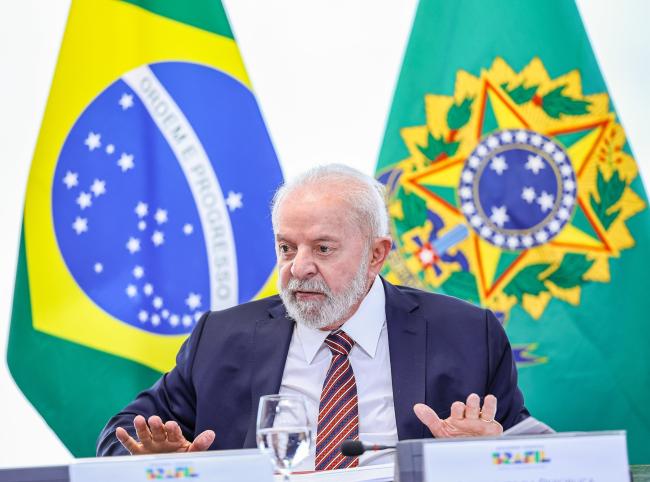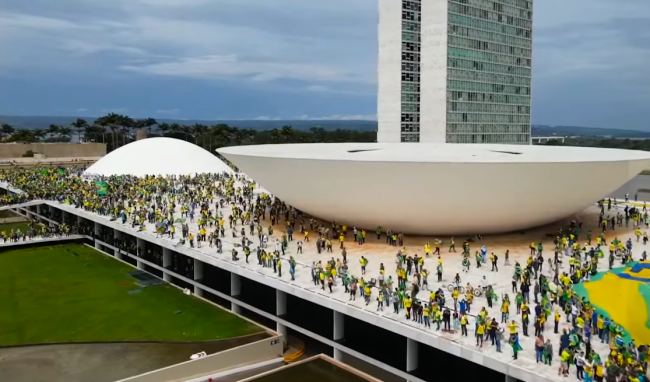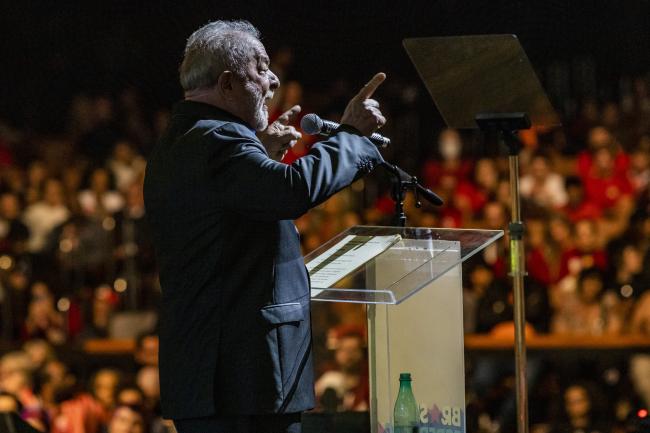
Following a historic win against far-right former President Jair Bolsonaro in October 2022, the third term of Luiz Inácio Lula da Silva as Brazil’s president was anxiously awaited. Lula’s victory meant not only the end of the most infamous government in Brazil’s recent history, but also the return of the politician whose previous administrations, from 2003 to 2010, lifted millions out of poverty, promoted notable economic growth, and positioned Brazil as an emerging global power.
The insurrection in Brasília on January 8, 2023, when thousands of Bolsonaro supporters stormed and destroyed the Three Powers Plaza, imposed severe challenges for Lula, who had been inaugurated just a week earlier. The new government had to spend the first months in crisis management mode, delaying the implementation of some policies and social programs. The attack exposed the complex structure of the contemporary right-wing movement in Brazil, whose coordinated yet decentralized interventions render it hard to combat, and shed light on long-lasting problems in institutions such as the military and the police. It was also a painful reminder that the elections were won on a razor-thin margin, raising the stakes for the new government even more.
“Lula III” effectively started following this remarkable event in Brazil’s history. What can we make of it a year later?
Supermilitarization Instead of Demilitarization
One of the most remarkable components of the January 8 insurrection was the ease with which the right-wing mob reached and broke through the modernist buildings of the three branches of government. Scenes of police officers ushering the march of protesters and insurrectionists through the streets of Brasília and passively watching the destruction carried out by the crowds; the low number of officers assigned to guard the Three Powers Plaza when intelligence had warned about potential escalation days prior to the attack; and hours of unresponsiveness by commanders point toward the high degree of leniency, at best, displayed by the police and the armed forces in the face of attempts against the country’s institutions. Indeed, both the military police and the three branches of the military have maintained characteristics from the dictatorship period until today, espousing a culture of violence and disregard for democracy, as well as refraining from public oversight and accountability. Not coincidentally, the military police and the military found in Bolsonaro their most perfect political expression—they both grew to become pillars of Bolsonarismo and left their marks on the January 8 attack.
At first, the Lula administration seemed to gesture toward responding to the authoritarian elements of the attack. Following a federal intervention in Brasília, the government considered measures claiming to prevent and counter future antidemocratic offensives, such as creating a civilian national guard and phasing out civil-military K-12 schools. The problem, however, is that none of the measures proposed in the aftermath of January 8 confronted the institutional model related to public safety and national security in Brazil, centered on punitive actions and militarized “solutions” to social problems.
In fact, Lula has not questioned the structure and the logic of Brazil’s police and armed forces; nor has he questioned the growing number of government offices occupied by members of the military since the 1990s. For example, even though the military showed little commitment to democracy even prior to January 8, Lula kept a retired general, Marcos Amaro, in charge at the Institutional Security Bureau (Gabinete de Segurança Institucional), the body responsible for crisis management and intelligence. Minister of Defense José Múcio, who is well-regarded among military types, has also remained in his position despite criticism for minimizing the insurrection and the post-election encampments linked to it.
Unfortunately, the government’s timid proposals to combat authoritarianism are not up to the indispensable task of dismantling a meaningful segment of the right-wing movement that has heavily settled in Brazil over the last decade. As Lula’s first year in office progressed, the administration’s willingness to publicly acknowledge serious institutional and structural problems in Brazil’s repressive apparatus slowly disappeared, and the government granted further funding to the Armed Forces. Furthermore, Operação Lesa Pátria, the probe launched to investigate the January 8 attack, adopted a “bad apple” approach toward the police and the military. While some officers may be found responsible for crimes, culpability will be solely on an individual basis, with both institutions largely shielded from scrutiny.

To make matters worse, at the close of 2023, Workers’ Party legislators and allies in Congress united with Bolsonaristas to swiftly approve a new law on the military police that further undermines a much-needed response to authoritarianism. Shutting down a discussion with social movements and civil society organizations, the government framed the new system as a reform of the dictatorship-era laws carried over to the democratic regime initiated in 1988. The approved legislation proposes the consolidation and sharing of online databases, as well as other technical and logistical upgrades, but its essence reproduces the worst of what was seen in the dictatorship: the formalization of the military police as a backup army, the undermining of public safety and ombuds offices, the granting of autonomy to carry out investigations and intelligence operations, and an expansion of the functions of the Armed Forces’ educational institutions. In short: supermilitarization when Brazil needs nothing short of demilitarization.
Despite the correct moves in the aftermath of the January 8 attack, Lula not only missed a precious chance to profoundly reshape Brazilian democracy but also effectively set a trap by legitimizing and emboldening those who have acted against it. The way the military police and the military—crucial pillars of Bolsonarismo—will conduct themselves moving forward is yet to be seen. In the end, the government opted for “pragmatism,” engaging in some bargains with the right wing in order to secure approval for what it considered “priorities”—the economic agenda, in particular.
Lula and the Economic Puzzle
When Lula ran and won in late 2022, the Brazilian population had been growing poorer for almost a decade. Indeed, Lula’s appeal rested, to a large degree, on his long-term commitment to fighting poverty and his critique of the many austerity policies—depreciation of the minimum wage, elimination of major social and labor rights, privatization of public companies, among others—seen in Brazil since the end of the Workers’ Party era.
In its first 100 days, the Lula government was able to restore some of the Workers’ Party’s flagship social programs—programs that improved the lives of millions of Brazilians: Bolsa Família, cash transfers to poor families; Minha Casa Minha Vida, construction and financing of affordable housing units; and Mais Médicos, provision of physicians in vulnerable areas, to mention the most significant ones. The minimum wage also increased. These measures are even more remarkable given the challenges the January 8 insurrection imposed on Lula and his team. But the continuity and expansion of these policies and programs is, above all, dependent on the way Lula III will deal with some of the hurdles that became visible in its first year.
Through the first months of the administration, Lula publicly criticized the Central Bank’s high interest rates, portraying them as an impediment to economic growth, public and private investment, and a robust social safety net. Yet, Lula’s record on the matter is worth remembering: his first government, from 2003 to 2006, witnessed rates that were much higher than the current ones. Both Lula I and II could deliver an economic boom and social welfare, high interest rates notwithstanding, showing that today’s criticisms are a tacit acknowledgment that a mere repetition of what was done in the past is not possible. In other words, Lula III needs to build state revenue to sustain social programs and a higher minimum wage amid a retrenchment of investments and consumption—not to mention that the early 2000s commodities boom is far behind us.
To achieve this, Lula opted to revive the most featured component of his second administration: large infrastructure projects. In August 2023, Lula set in motion the third iteration of the Growth Acceleration Program (Programa de Aceleração do Crescimento or PAC, in Portuguese). Originally launched in 2007, the program was expanded under President Dilma Rousseff but came to a halt following the 2016 coup against her. Large-scale investments in construction, energy, sanitation, transportation, urban mobility, and education are expected, including novel efforts towards energy transition and digital inclusion. The program will maintain the basic structure previously seen, in which the federal government, states, municipalities, and the private sector work together in partnerships.

Ultimately, the idea is to trigger a so-called virtuous cycle: government spending will support job creation, the expansion of consumption, and, hence, further economic activity—resulting in increased state revenue. Lula and his team have estimated 1.7 trillion reais in public and private investments. While the absolute numbers are higher than in the past, the new program projects a lower investment rate, so the country’s productive capacity would expand at a slower pace. The question then emerges: can the new PAC bring about the expected results?
The question is even more relevant as the new program faces serious limitations imposed by the government’s own fiscal approach: the administration has determined to balance budgets to guarantee credibility and predictability for Brazil’s economy, but the result is a cap on investments. Under the rhetoric of “responsibility,” the adopted fiscal approach is nothing but a traditional neoliberal recipe for the capitalist periphery, encouraged to avoid deficits and optimize the way the state functions. Indeed, Fernando Haddad, the current Minister of the Economy, has stated that the government will pursue a zero deficit in 2024. With more restrictions around the budget than previous administrations, Lula III will end up requiring much more from private and foreign investments, though the federal government will remain an important player. This is a dangerous course of action since the state as a protagonist in promoting growth is exactly what made the Workers’ Party administrations successful—private and foreign investments cannot be expected to be a lever of development in a country such as Brazil.
This is not to say that tragedy is inevitable, but poor performance of the economy, policies, and social programs would be frustrating in light of the hope deposited in Lula—and Brazil cannot afford frustration now.
Thus far, Lula III has maintained the model that characterized the previous Workers’ Party administrations: working within (and not against) neoliberalism’s fundamental framework. The model assumes no major confrontation or effective polarization with the dominant classes and, thus, allows benefits to the other classes and social transformations to the extent that conflict does not emerge or is under control. Lula III, however, enjoys much less room for conciliation; the conservative segment of Brazilian society is much more organized and authoritarian today. Throughout the year, right-wingers in Congress pressured Lula to change his cabinet and concede some critical offices—even though he had accommodated former Bolsonaro supporters at the onset. The government caved in, following a pattern of concessions to the dominant classes and their representatives when fomenting popular mobilization to sustain a solid progressive agenda could, instead, have been an alternative. Lula III is a chance to correct the problems and shortcomings of the past; unfortunately, the Workers’ Party seems willing to double down on them.
The lives of Brazilians are undoubtedly better one year after Lula returned to power—unemployment has declined, some personal debt has been canceled or renegotiated, a new and more robust package of affirmative action has been launched, and the rights of women, LGBTQI+, and Indigenous people are back on the agenda. But that is not precisely the point. The point is to consider whether such a model is sustainable—and the trials and tribulations seen under Rousseff offer a clue to the answer. More importantly, the priority nowadays is to consider whether the current model is the best strategy to confront the right-wing movement and address the aspirations of millions—who have either deposited their hopes in Lula once again or have channeled their disappointment otherwise. There is still time, however, for Lula III to change courses and pave the way to structural, rather than palliative, transformations that are so long overdue.
Nara Roberta Silva is a core faculty member and Praxis Program head at Brooklyn Institute for Social Research, where she teaches about social movements, race, and social theory. She is on Twitter @nararosilva.

